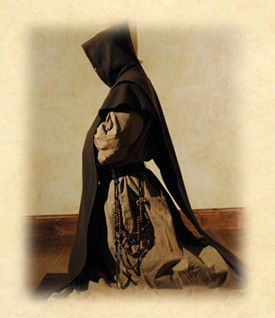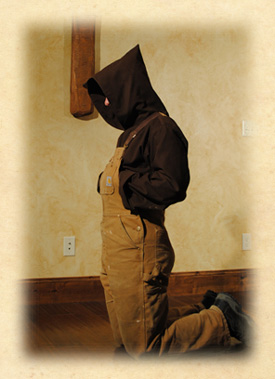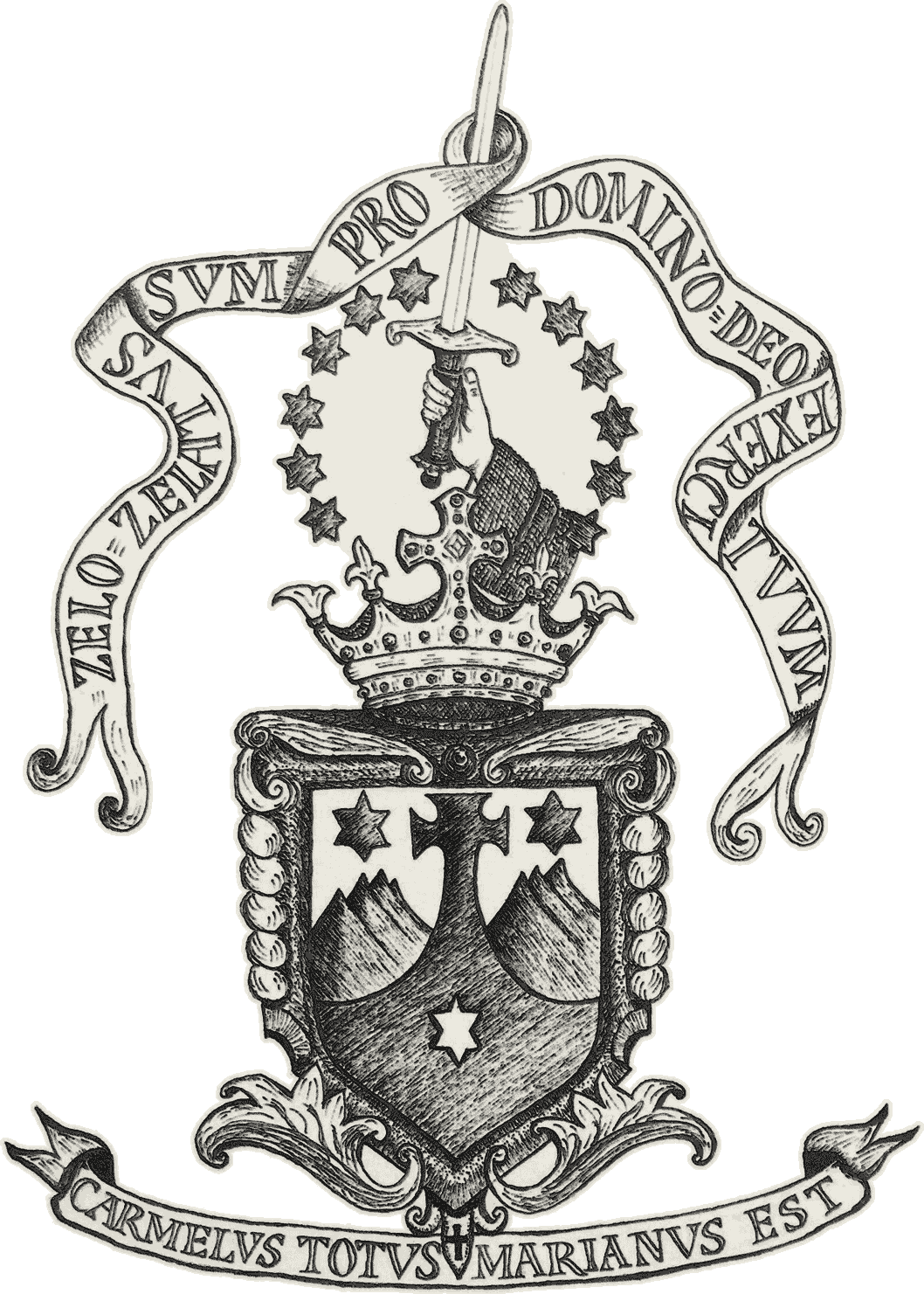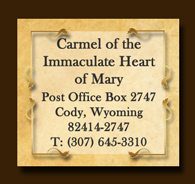The Carmelite monk, like a soldier, is clothed in the armor of the habit as he bravely does battle for God and for souls. Although the Holy Scapular is the habit properly speaking, each article of the monk's clothing has been entrusted by Holy Mother Church with a significance that urges him on to the heights of holiness: mystical union with God.
The habit of the Carmelite monk is made of durable brown wool as woven after the manner St. Teresa of Jesus first taught her daughters. Brown like the cross and the soil of the earth, the Carmelite wears a robe of brown, since he is called to carry the Cross of Our Lord, Jesus Christ and to imitate the humility of the Blessed Virgin.
The Tunic of the New Man
The monastic tunic, commonly known as a monk's robe, clothes the monk in modesty. Although not commonly known, tunics were the garments worn by men throughout history until modern times. Now however, the tunic stands as a sign of contradiction to modern fashion and the vanity of the world that the monk leaves behind when he enters the monastery.
When a monk is clothed in the tunic at the time of his Investiture in the Holy Habit, the suit coat is taken off and in its place the prior invests him in the tunic. While doing so, the prior prays, “May the Lord clothe you a new man, who is created according to God in justice and holiness of truth.” Indeed, the tunic is ultimately this: a sign of the new man who has renounced the world that he might be united to God and bring God to the world through his life of prayer and penance.
Girded with the Cincture of Chastity
St. Albert, the legislator of the Carmelite Rule, prescribes that the monk's "loins must be girt with the belt of chastity." The cincture is just that, a leather belt that the monk ties over the tunic at the waist. How prophetic are the words spoken by the prior when the monk receives the cincture, “When you were younger, you would gird yourself, and would walk where you willed; but since you will be older, another will gird thee.” This mysterious “another” is the Blessed Virgin whom the monk takes not only as his Heavenly Mother, but also mystically as his sister and greatest love among men.
In imitation of Our Lady's virginal purity and that of St. Joseph, the monk girds his loins in chastity. The Carmelite does not marry or have natural children that he might have instead as spiritual children all the souls whom God places before him, both known and unknown.
The Carmelite monk's cincture hangs on the right to the bottom hem of his tunic. On the left from the cincture hangs the Most Holy Rosary. The monk has his spiritual weapons around his waist; like a cowboy or a soldier, the Carmelite monk must always be prepared for spiritual warfare with the virtue of holy purity and the power of the Rosary of the Virgin Mother.
Monastic Cowl
The cowl (sometimes known as a capuche, especially for friars) is the hood worn by the Carmelite monks. The monk wears a monastic cowl that hangs over his upper back and is used to cover his head during the winter months. Although the cowl serves a practical purpose in keeping the monk's shaven head warm, the cowl is more importantly a sign of mourning. The word “monk” is derived from Greek words meaning “one who mourns in solitude.” So what does a monk mourn? The Carmelite monks mourn for their own sins and the sins of others, begging for God's mercy and justice. The cowl is a reminder of Christ's Dolorous Passion on Calvary for sinners, a death that He would have endured had there been but one poor sinner.
The Holy Rule exhorts the Carmelite to “place the helmet of salvation on [his] head,” and this is what the Carmelite does every time he covers his head with the cowl. His head being covered in the brown wool and his face hidden unless you look directly at him, the monastic cowl also serves to hide the monk so that God alone might know his countenance.
The Scapular: A Privilege Indeed
The Scapular is truly the “garment of salvation”, although it is humble even in its appearance. The scapular can best be recognized as the brown rectangular piece of fabric that hangs down the monk's front and back, covering the tunic and hiding the monk's hands folded beneath. Until Our Lady of Mount Carmel appeared to St. Simon Stock in 1251, the scapular was worn by many and varied religious orders as an apron to protect the tunic when working. It can be said that the scapular was the least important garment of the habit, a garment of work, a garment of a slave. And yet, the Blessed Mother offered the Scapular to St. Simon Stock in response to his prayer for a privilege and as a sign of Her particular love for the Order of Carmel. In the gift of the Holy Scapular, we see Our Lady's humility: she is truly the Handmaid of the Lord, so how appropriate it is that she gave to Her Carmelites the garment of a slave as their privilege.
At the reception of the Scapular, which is simply the making of a Carmelite, the prior urges, “Take up the sweet yoke of Christ, and his light burden.” The Scapular is a constant reminder of the Cross borne by Our Blessed Lord for it shares its brown color and both are borne upon the shoulders. In this conformity to our Savior, we first conform ourselves to Mary and the “burden” becomes utter sweetness. The Scapular, long venerated and upheld by pope after pope, is indulgenced and its promise is protection from hell's flames. The Carmelite monks, seeking to distinguish themselves from other Carmelite religious, wear the Scapular over the cowl. It is interesting to note that St. Teresa had her daughters wear the Scapular as the top vestment worn by her daughters as well, centralizing the role of the Brown Scapular in the Carmelite Habit.
Monks in Sandals
Ss. John of the Cross and Teresa of Avila when instituting the Discalced Reform of Carmel in the sixteenth century prescribed a return to the poverty of the original hermits on Mount Carmel. This poverty was manifested in many ways, but one of the best-known ways was that the Discalced Carmelites did not wear shoes. The word “discalced” actually means “barefooted” or “shoeless.” Although originally the Discalced Fathers did not wear shoes and went about barefoot, St. Teresa of Jesus moderated their austerity by urging them to wear poor sandals.
The Carmelite monks in seeking to imitate the purity and wisdom of the Carmelite life, prescribed by these great saints, wear poor leather sandals crafted by their own Brother Cobbler. Through the winter and cold months, the sandals are especially a reminder of the poor, and those in our society who are truly cold and without protection from the harshness of winter. The Carmelite Monks are conformed more perfectly still unto Our Lord whose poverty in this world was real and chosen.
Profession Crucifix
A monk when making his temporary profession receives the Profession Crucifix, which is worn upon the heart by being attached to a buttonhole on the tunic. The Profession Crucifix with its cross of wood and metal corpus is an outward sign of the conformity to Christ, which is sealed in the profession of the Vows of Obedience, Chastity and Poverty. Worn over the heart, the Profession Crucifix is also a reminder that the monk has now given his heart to Christ in immolating himself for the love of God and the salvation of souls.
As one hymn proclaims, “Hail, O Cross, our only hope.” Indeed it is this very cry that must gush forth from the professed monk's heart as his prayers challenge the world to embrace the Cross of Christ and to stand at the foot of that infamous gibbet with the Blessed Mother, St. John, St. Mary Magdalene and the others gazing up at Him whom we have pierced.
More marvelous still, the Profession Crucifix is hidden below the Scapular and not outwardly visible; this too ought to inspire the Carmelite to hide his sufferings, his little crosses, that God alone might know them.In order to safeguard the poverty of the monastic life, each monk is permitted to two choir habits, a work habit, and a modified work habit to be worn as needed. It is permissible in hot and humid places to allow another brown material to be substituted for wool.
The Monastic Tonsure
A shaven bald head has been continually identified as a sign of a man's consecration to God and complete offering of himself to the service of Christ and His Church. We read in the Fourth Book of Kings that forty-two young boys of Bethel who had been raised with a prejudice against the true religion and its ministers mocked St. Elisha, the disciple of St. Elijah. And how was he identified and mocked? The boys said, “Go up, thou bald head; go up, thou bald head.” Here we see that a bald head was a contradiction even in those days before Our Lord's life on earth. And still today the baldhead is a contradiction to the world's fashion and haircuts. The Carmelite monks wear the tonsure as yet another reminder that they have confounded the wisdom of the world and chosen instead the wisdom of the saints. The tonsure is a penance, too. In Wyoming's cold winters a bald head, like feet without shoes, is a penance. The monks embrace this opportunity to show obedience to the Church and the monastic tradition.
The priests and seminarians of the monastery have a thin crown of hair however, commonly called a corona that circles their heads as a reminder of the priestly dignity and duty.
The Mantle of Our Lady of Mt. Carmel
In a vision, Blessed Angela de Arena saw Our Lady of Mount Carmel and the saints dedicated to Her during their lives, but Bl. Angela saw no Carmelites. Asking the Blessed Mother where the Carmelites were, the Queen of Heaven pulled back Her white mantle and hidden below were Her Carmelite saints appearing as roses. The white mantle worn by Carmelites is an extension of the mantle of Mary where she protects and hides souls that have recourse to Her.
The white mantle worn by the Carmelite monks for Holy Mass and the Divine Office on major feast days covers the brown tunic, scapular and cowl below, clothing the monk in white. This mantle is a "sign of [the] internal purity" which the monk aspires to in imitation of Our Lady; it is therefore most fitting that the mantle is worn at these times as a reminder not only of the purity with which the monk should approach God, but also that the monk should approach God clothed in the virtues of the Immaculate Mother.
The Work Habit
 It is our charism that all the monks should be engaged in manual labor according to the Holy Rule, " you must do some kind of work, so that the devil will always find you occupied." As much as we love our woolen habits, they are not durable enough to withstand the abrasiveness of hard manual labor. To combat this, monks and nuns have always had a specific habit for work that looks similar to their choir habits. Following this very practical tradition we have designed a work habit of our own. In our work habit we have retained the capuche and scapular but have replaced the wool tunic with one made of a canvas material similar to Carhartt. This canvas material is much more durable and holds up well as the brothers carry out the chores of the monastery. Our Holy Mother St. Teresa of Jesus always taught her daughters to keep their habits neat and clean. The brothers therefore, by having work habits, keep their choir habits in a condition suited for Mass and the Divine Office.
It is our charism that all the monks should be engaged in manual labor according to the Holy Rule, " you must do some kind of work, so that the devil will always find you occupied." As much as we love our woolen habits, they are not durable enough to withstand the abrasiveness of hard manual labor. To combat this, monks and nuns have always had a specific habit for work that looks similar to their choir habits. Following this very practical tradition we have designed a work habit of our own. In our work habit we have retained the capuche and scapular but have replaced the wool tunic with one made of a canvas material similar to Carhartt. This canvas material is much more durable and holds up well as the brothers carry out the chores of the monastery. Our Holy Mother St. Teresa of Jesus always taught her daughters to keep their habits neat and clean. The brothers therefore, by having work habits, keep their choir habits in a condition suited for Mass and the Divine Office.
For more serious work like running equipment or branding cattle, the brothers wear overalls with the monastic capuche. This garb is dubbed the "extraordinary work habit" and it serves as a protection for the brothers' safety during serious work.
The work habit serves as a powerful reminder to the monk that his work too is consecrated to God through the vows. This reality keeps the monk focused on the spiritual realities always before him and reminds him continually of his mission to generate love within the heart of the Church. Thus the monk strives to sanctify the entire day, even at work periods, by uniting his labor with prayer.


